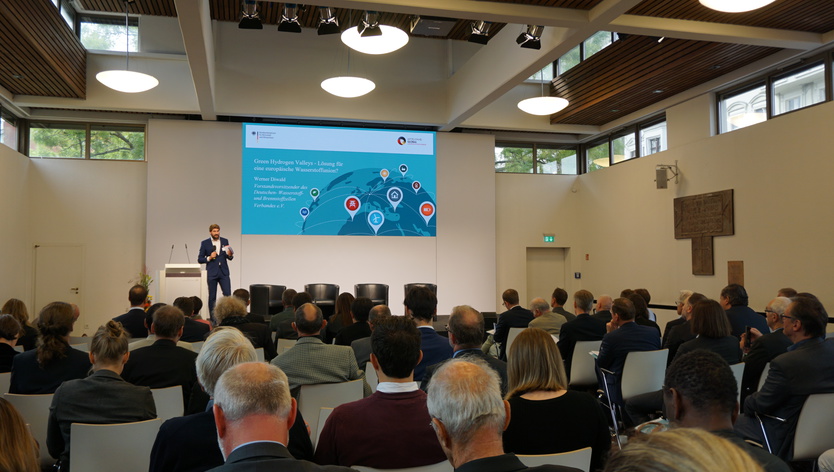
© Geschäftsstelle der Exportinitiave Energie
"We will see the market ramp up sooner than we thought," State Secretary Dr. Patrick Graichen stated in his opening remarks on 15 September 2022 in Berlin. It was the German Energy Solutions Initiative’s first purely physical annual event since 2019. Some 130 participants and attendees came to network and share their expertise on green hydrogen. According to Graichen, the emerging market is moving so fast that the ministry is currently revising its own scenarios: "There will be higher consumptions as early as 2030."
Prof. Dr. Detlef Stolten of the Jülich Research Center brought current figures from his modelling: By 2045, 5.5 million tons of H2 will be produced domestically. Another 4.9 million tons will have to be imported. "With total energy demand at 1,400 TWh, Germany would then have around 400 TWh from hydrogen." About 70% of German energy consumption will be covered by electricity and 30% by hydrogen, of which just under half will be imported. Stolten cited several reasons for the need for imports:
- cheaper renewable electricity abroad to use for electrolysis,
- acceptance problems if more renewable energy plants had to be built in Germany for H2 production, and
- globally, the wind blows and the sun shines more steadily than in any one country.
As a small, positive side effect, Stolten added, "The number of countries that can export green H2 is far greater than the number of fossil exporters."
For Werner Diwald, head of the German Hydrogen and Fuel Cell Association (DWV), geopolitics is also an advantage with green hydrogen: It's easier to switch to other countries if supplies from one country fail. Diwald emphasizes that electrification is the focus: "We're coming out of a molecular energy world and going into an electron world." Still, green hydrogen is important, especially for imports: "A single H2 pipeline from North Africa transports as much energy as eight HVDC lines." Referring to the new RePower EU plan, Diwald assumes there will be 125 GW of installed capacity and 350 TWh/a of generation by 2030 worldwide. Result: an investment requirement of €500 billion inside and outside the EU.
But banks need to get on board, says Stephan Poth of German international cooperation agency GIZ: "The bank will only finance what it understands - and that's where we can help." Specifically, he is referring to the International Hydrogen Ramp-up Programme, or H2Uppp, which helps companies with project development and is implemented by GIZ. Poth announced a first success story at the event: a public-private partnership (PPP) for the production of green methanol in Mexico. Jörg Fromme, who advises companies individually on financing issues for the Initiative, was also on hand to answer financing questions.
Creating an H2 consortium
Another option to enter the H2 market faster is to form a consortium. One successful H2 consortium presented itself to the audience: TUNol, which aims to produce green methanol from renewable electricity by means of Concentrated Solar Power (CSP) - also with an eye on the German market. With support from the Initiative, five companies found each other and developed a joint project. "For me, the information event was crucial," said Nader Ben Said of Diwan International Engineering GmbH. Thorsten Schnorbus of FEV Europe GmbH is another member of the TUNol consortium. His company works closely with the automotive industry and sees H2 as an opportunity to diversify its business. BMWK's support is particularly important, he says, because "the market isn't there yet, but it's coming." For Schnorbus, the key question is, "How can I scale up the project?" Indeed, consortium formation is precisely about identifying projects that the consortium can implement in other target markets.
Creating a consortium is a complex process accompanied by a moderator for the Initiative. Frank Eibisch from BC Berlin Consult GmbH moderates H2 projects. For him, it is particularly important to set milestones for the consortium. With TUNol, for example, there were difficulties: In the middle of it, a member who had established himself as group leader changed jobs. "The whole thing was on the back burner," says Said. But then, Eibisch says, the group came together all the more: "The member's tasks weren't taken over by someone else, but were divided up quasi democratically within the group." Said says moderation was essential: "Without that support, I don't know if the consortium would have stayed together."
In the afternoon, event participants delved deeper into the topics in three workshops:
- H2-Uppp: what do companies need to do to benefit from a PPP?
- Potential: where is the biggest market potential?
- Project-related: identify concrete projects and find partners for cooperation and potential consortia along the value chain.


